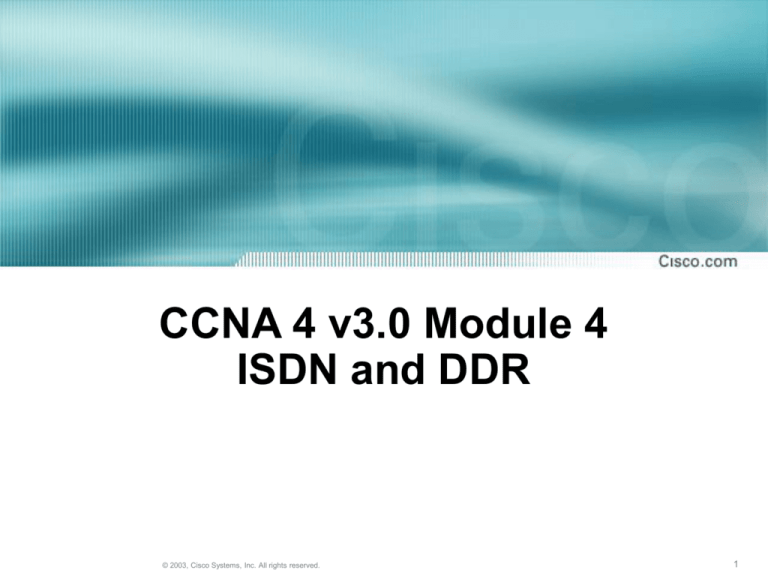
CCNA 4 v3.0 Module 4
ISDN and DDR
© 2003, Cisco Systems, Inc. All rights reserved.
1
Purpose of This PowerPoint
• This PowerPoint primarily consists of the Target
Indicators (TIs) of this module in CCNA version
3.0.
• It was created to give instructors a PowerPoint to
take and modify as their own.
• This PowerPoint is:
NOT a study guide for the module final assessment.
NOT a study guide for the CCNA certification exam.
• Please report any mistakes you find in this
PowerPoint by using the Academy Connection
Help link.
© 2003, Cisco Systems, Inc. All rights reserved.
2
To Locate Instructional Resource
Materials on Academy Connection:
• Go to the Community FTP Center to locate
materials created by the instructor community
• Go to the Tools section
• Go to the Alpha Preview section
• Go to the Community link under Resources
• See the resources available on the Class home
page for classes you are offering
• Search http://www.cisco.com
• Contact your parent academy!
© 2003, Cisco Systems, Inc. All rights reserved.
3
Objectives
• ISDN concepts
• ISDN configuration
• DDR configuration
© 2003, Cisco Systems, Inc. All rights reserved.
4
Digital Communication with ISDN
© 2003, Cisco Systems, Inc. All rights reserved.
5
ISDN Benefits
© 2003, Cisco Systems, Inc. All rights reserved.
6
ISDN Standards
© 2003, Cisco Systems, Inc. All rights reserved.
7
ISDN Access Options
© 2003, Cisco Systems, Inc. All rights reserved.
8
ISDN 3-Layer Model
© 2003, Cisco Systems, Inc. All rights reserved.
9
Q.931 Messaging-Call Setup Example
© 2003, Cisco Systems, Inc. All rights reserved.
10
Call Processing
1.
The D channel is used to send the called number to the
local ISDN switch.
2.
The local switch uses the SS7 signaling protocol to set
up a path and pass the called number to the remote
ISDN switch.
3.
The remote ISDN switch signals the destination over the
D channel.
4.
The destination ISDN NT-1 device sends the remote
ISDN switch a call-connect message.
5.
The remote ISDN switch uses SS7 to send a callconnect message to the local switch.
6.
The local ISDN switch connects one B channel end-toend, leaving the other B channel available for a new
conversation or data transfer. Both B channels can be
used simultaneously.
© 2003, Cisco Systems, Inc. All rights reserved.
11
ISDN Functions and Reference Points
© 2003, Cisco Systems, Inc. All rights reserved.
12
ISDN Functions and Reference Points
© 2003, Cisco Systems, Inc. All rights reserved.
13
BRI Reference Points
© 2003, Cisco Systems, Inc. All rights reserved.
14
Cisco ISDN BRI Interfaces
© 2003, Cisco Systems, Inc. All rights reserved.
15
ISDN Interfaces
S/T ISDN Interface
U ISDN Interface
© 2003, Cisco Systems, Inc. All rights reserved.
16
ISDN Switch Types
© 2003, Cisco Systems, Inc. All rights reserved.
17
Configuring ISDN BRI
© 2003, Cisco Systems, Inc. All rights reserved.
18
Configuring ISDN BRI
© 2003, Cisco Systems, Inc. All rights reserved.
19
Configuring ISDN PRI
© 2003, Cisco Systems, Inc. All rights reserved.
20
Switch Types Available for ISDN PRI
Configuration
© 2003, Cisco Systems, Inc. All rights reserved.
21
ISDN PRI Examples
© 2003, Cisco Systems, Inc. All rights reserved.
22
Verifying ISDN Configuration
© 2003, Cisco Systems, Inc. All rights reserved.
23
Troubleshooting ISDN Configuration
© 2003, Cisco Systems, Inc. All rights reserved.
24
DDR Operation
© 2003, Cisco Systems, Inc. All rights reserved.
25
DDR Operation
© 2003, Cisco Systems, Inc. All rights reserved.
26
Configuring Legacy DDR
© 2003, Cisco Systems, Inc. All rights reserved.
27
Defining Static Routes
• When configuring static routes, consider
the following:
By default, a static route will take precedence
over a dynamic route because of its lower
administrative distance. Without additional
configuration, a dynamic route to a network
will be ignored if a static route is present in the
routing table for the same network.
To reduce the number of static route entries,
define a summarized or default static route
© 2003, Cisco Systems, Inc. All rights reserved.
28
Specifying Interesting Traffic
© 2003, Cisco Systems, Inc. All rights reserved.
29
Configuring Dialer Information - PPP
© 2003, Cisco Systems, Inc. All rights reserved.
30
The dialer-group Command
© 2003, Cisco Systems, Inc. All rights reserved.
31
The dialer-map Command
© 2003, Cisco Systems, Inc. All rights reserved.
32
The dialer idle-timeout
Command
© 2003, Cisco Systems, Inc. All rights reserved.
33
Dialer Profiles Overview
• Define encapsulation and access control lists
• Determine minimum or maximum calls
• Turn features on or off
© 2003, Cisco Systems, Inc. All rights reserved.
34
Dialer Profile Elements
© 2003, Cisco Systems, Inc. All rights reserved.
35
Configuring Dialer Interfaces
© 2003, Cisco Systems, Inc. All rights reserved.
36
Verifying DDR
• show dialer
• show dialer interface [BRI]
• show isdn active
• show isdn status
© 2003, Cisco Systems, Inc. All rights reserved.
37
Troubleshooting DDR
• debug isdn q921
• debug isdn q931
• debug dialer [events|packets]
• isdn call interface
• clear interface bri
© 2003, Cisco Systems, Inc. All rights reserved.
38




